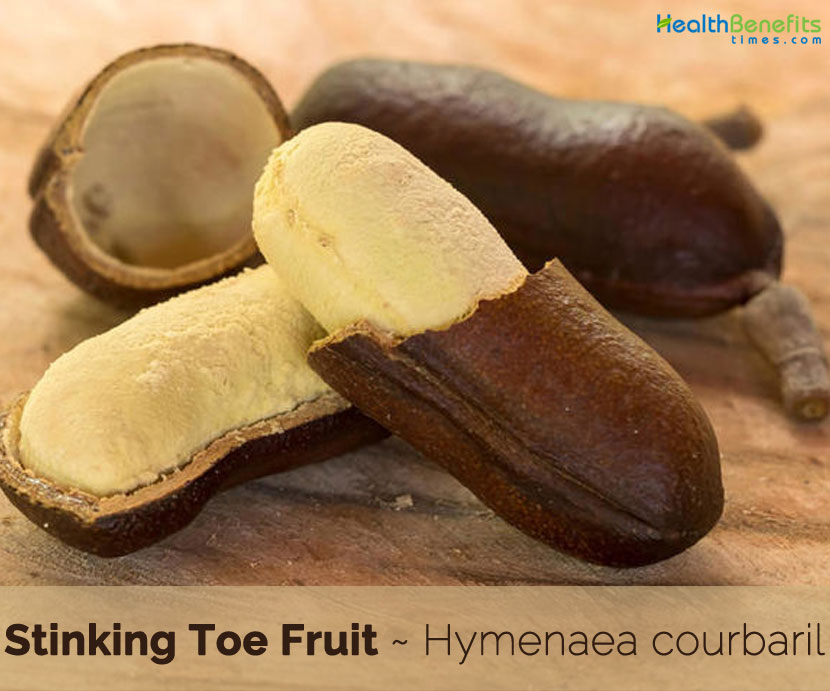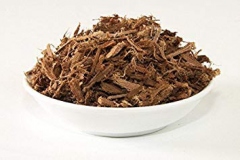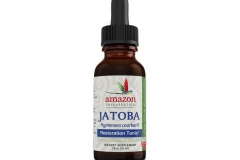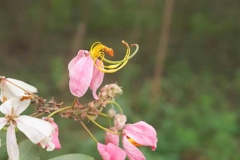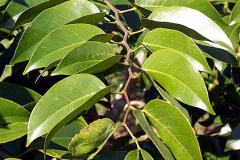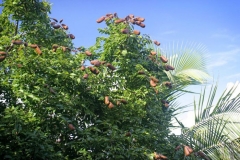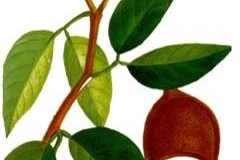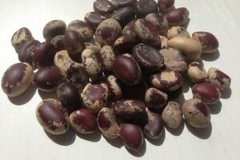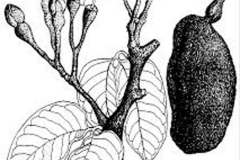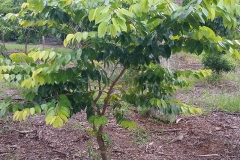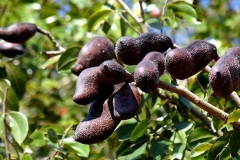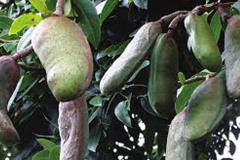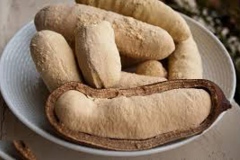It is also known as stinking toe, old man’s toe, and stinktoe because of the unpleasant odor of the edible pulp of its seed pods. It is a very important multi-purpose tree harvested from the wild as a local source of food, medicines and various commodities. Bark, resin, and leaves are used for a variety of health conditions, including candida, diabetes, asthma, bronchitis, and prostatitis. Stinking Toe Fruit can be made into a decoction or tea, or taken as a supplement. Some users find that it has a mild stimulant effect and thus avoid consuming it at night. It is exploited commercially for its timber and gum; is sometimes cultivated and encouraged to grow semi-wild as a food crop and has also been planted as an ornamental in parks all over the tropical world. It has limited ornamental use as a shade tree in parks and on streets because the heavy seed pods emit an offensive odor as they mature and can cause damage or injury when they fall. It is a hardwood that is used for furniture, flooring, and decoration. Its hard fruit pods have edible dry pulp surrounding the seeds. Its sap, called animé, is used for incense, perfume, and varnish.
Plant Description
Stinking Toe Fruit is a medium to large sized, noble, spreading, evergreen tree with massive spreading branches and a heavy, umbrella-shaped crown. It grows slowly, but can reach an eventual height of 30 meters, with some specimens up to 45 meters. The plant is found growing in a wide range of habitats including tropical dry forest, transition to pre-montane moist forest, and tropical wet forest as well as subtropical moist forest. The plant grows on all textures of soil from sand to clay but develops best on deep, fertile, moist and well-drained sandy soils. It tolerates poor fertility soils and waterlogging soil. Plant’s straight, cylindrical bole can be un-branched for 12 – 24 meters and is usually 60 – 120 cm in diameter, though specimens up to 150 cm have been recorded. Bark is smooth, becoming 2.5 cm or more thick, grey to pinkish-brown.
Leaves
Leaves alternate, compound, bifoliate, 5-10 cm long and 3-5 broad, gland-dotted; stipules soon falling. Petiole is 12-30 mm long; petiolules twisted, 2-4 mm long, leaflets are ovate to lanceolate, curving slightly towards each other, 3-12 cm long and 1.5-7 cm wide, apex acute to obtuse, base oblique, margins entire, glabrous, shiny and leathery with small glands and prominent veins below, petiolules are 2-8 mm long. They are glossy dark green color above and paler below.
Flower
Inflorescence is terminal, densely corymbose-paniculate, 8-15 cm long and wide; pedicel 6 mm long. Flower are large, buds up to 3.5 cm long, open flower 3 cm in diameter, all parts glandular punctate; calyx is campanulate, 4-merous, grey-green, tube (hypanthium) 6 mm long, lobes ovate to elliptical, 15-18 mm long and 8 mm wide, imbricate, coriaceous, pubescent outside, sericeous inside; petals are sub-equal, oblong, ovate or obovate, equalling the calyx lobes or slightly longer, not clawed, yellow, streaked with red. Stamens are 3.5 cm long, free, filaments white, folded in bud, anthers red, dorsifixed; pistil with stipitate ovary, stipe 4-8 mm long, ovary with about 15 ovules, style slender, curved about 2.5 cm long.
Fruit
Fertile flower are followed by indehiscent (that do not open when ripe) woody legumes with oval section, 4-16 cm long, 2-6 cm broad, and 2-3 cm thick and slightly kidney-shaped. They are initially green when young turning to reddish brown as they are mature. An odor is released when the shell of the pod is broken; the smell is described as “off-putting” and the recommendation are generally to avoid the aroma. The fruits consists of 1-5 slightly compresses ellipsoid seeds, 2-3 cm long and 1,8-2,5 cm broad, of glossy brown red color. Each seed is individually covered with the flesh. The texture is very dense and dry and the flavor is sweet, like powdered sugar. Each of the seeds is the same general shape as the outer-shell, just much smaller and should be discarded. Pods weigh about 10-50 g and the pulp accounts for less than 20% of this weight. If consumed raw it tends to stick inside the mouth like dry dust. It is one of the richest vegetable foods known because of its high concentrations of starches and proteins. It is further an excellent concentrated feed for animals.
Worldwide Ethno-botanical Uses
| Stinking Toe Fruit Quick Facts | |
|---|---|
| Name: | Stinking Toe Fruit |
| Scientific Name: | Hymenaea courbaril |
| Origin | American tropics and is distributed in the West Indies, and in Central and South America from southern Mexico to Brazil |
| Colors | Green when young turning to reddish brown color as they mature |
| Shapes | Compressed cylindrical pod, 8-20 cm long 4-8 cm wide, smooth or rough but not rugose, dark brown |
| Health benefits | Keeps Your Eyes Healthy, Wards off Iron-Deficiency Anemia, Increases Appetite, Slows Down the Aging Process, Source of Carbohydrates, Antifungal, Respiratory System, Weight Loss, Fight against Infections, Treats Meningitis, Treat Retention of Liquids, Treatment of Inflammation,Fight against Asthma |
| Country | Uses |
| Amazonia | Eyes (wounded or sore), menstrual discharge, vermifuge |
| Brazil | Aches, ache (stomach), anemia, anuria, appetite (lack of), arthritis, asthma, astringent, athlete‘s foot, bladder, blennorrhagia, bronchitis, bursitis, carminative, catarrh, colic, cough, cystitis, decongestant, diarrhea, digestive, dysentery, dyspepsia, dysuria, energy, expectorant, fever, flatulence, fungicide, gastric atonia, hemorrhage, hematuria, hemoptysis, hepatitis, infections (yeast & fungi), laryngitis, laxative, lung, pains, pectoral, prostatitis, secretions (purulent), sedative, skin, stomachic, tonic, tuberculosis, urethritis, urine retention, vermifuge, wound |
| Elsewhere | |
| Anti-inflammatory, asthma, beri-beri, blennorrhagia, bronchitis, cystitis, dyspepsia, expectorant, indigestion, laryngitis, liqueur, malaria, pain (testicles/prostate), prostatitis, rheumatism, stomachic | |
| Guatemala | Diuretic, fever, rheumatism, sudorific, ulcer (mouth) |
| Haiti | Antiseptic, arthritis, asthma, bruise, catarrh, diarrhea, emphysema, headache, intestine, kidney, laxative, respiratory, rheumatism, sore, spasm, stomach |
| Mexico | Asthma, catarrh, purgative, rheumatism, sedative, sore, venereal |
| Panama | Asthma, diabetes, diarrhea, hypoglycemia, stomach, ulcer (mouth) |
| Peru | Cough, cystitis, diarrhea, hepatitis, prostatitis |
| Venezuela | Fracture, lung, vermifuge |
Ethno-medical Information on Stinking Toe Fruit
| Plant Part | Location | Ethnic Use | Type Extract / Route | Used For |
| Bark | Amazonia | Used as a vermifuge, applied to wounded or sore eyes, and taken orally to stop
Excessive menstrual discharge. |
Various / Various | Human Adult |
| Bark | Brazil | Used for stomach trouble. | H2O Ext / Oral | Human Adult |
| Bark | Brazil | Used as a tonic. Used for the stomach, as an astringent, for weakness, debilitation, lack of appetite, gastric atonia, flatulence, diarrhea, hematuria and for catarrh of the respiratory and urinary tract. | Hot H2O Ext / Oral | Human Adult |
| Bark | Brazil | Used for athlete’s foot and foot fungus. | Infusion / Topical | Human Adult |
| Bark | Brazil | Used as a tonic and energizer. Used to keep a good appetite. Used for chronic
coughs, asthma, lung weaknesses, laryngitis, bronchitis, hemorrhage, bursitis, Bladder infections, yeast and fungal infections, cystitis, arthritis and prostatitis. Used for its decongestant and antifungal properties. |
Infusion/Oral | Human Adult |
| Bark | Brazil | Used to decongest the urinary tract, for cystitis and prostatitis, as an anti-inflammatory to the bladder. Used as an energizer and tonic; as a decongestant for respiratory problems; to reduce inflammation, to clear toxic pus, for painful urination and dribbling and for pain in the testicles or prostate. | Decoction / Oral | Human Adult |
| Bark | Brazil | Used for cystitis, hepatitis, prostatitis and tuberculosis. | Hot H2O Ext / Oral | Human Adult |
| Bark | Brazil | Used for athlete’s foot or food fungus. Used for diarrhea | Infusion / Various | Human Adult |
| Bark | Brazil | Used for stomach troubles. | Not stated | Human Adult |
| Bark | Brazil | Used for acute and chronic cystitis, prostatitis, blennorrhagia, diarrhea and dysentery. | Decoction / Oral | Human Adult |
| Bark | Brazil | Used as an astringent, sedative and carminative for inflammation of the prostate, hemorrhage, diarrhea, dysentery, dyspepsia, coughs and bronchitis. | Decoction/Oral | Human Adult |
| Bark | Brazil | Used for hemoptysis, hematuria, diarrhea, dysentery, colic, to fortify the system and to improve appetite. | Hot H2O Ext / Oral | Not Stated |
| Bark | Brazil | Used as a tonic, stomachic, astringent, balsamic, vermifuge and hemostatic | Hot H2O Ext / Oral | Human Adult |
| Bark | Brazil | Used as an astringent and pectoral. Used for skin diseases. | Decoction / Oral Bath / External | Human Adult |
| Bark + Leaf | Brazil | Used for bronchitis and coughs, bladder and prostate problems and as an astringent | Hot H2O Ext / Oral | Human Adult |
| Bark + Leaf | Brazil | Used for diarrhea, dysentery and intestinal colic. Used for coughs, bronchitis, catarrh, asthma and pulmonary weakness. | Decoction/Oral | Human Adult |
| Leaf | Brazil | Used for affections of the urinary system, chronic cystitis and prostatitis. | Decoction / Oral | Human Adult |
| Resin | Brazil | Used for bronchitis | H2O Ext / Oral | Human Adult |
| Resin | Brazil | Used for coughs, bronchitis, asthma, laryngitis and as an expectorant. Used for cystitis, urethritis, purulent secretions of the respiratory or urinary tract | Resin/Oral | Human Adult |
| Resin | Brazil | Used as a tonic, balsamic, stomachic and vermifuge. | Resin/Oral | Human Adult |
| Resin | Brazil | Used to relieve aches and pains. | External | Human Adult |
| Resin | Brazil | Used for general debilitation, for pulmonary affections, for coughs, bronchitis, asthma, hemoptysis, worms and a lack of appetite, for acute and chronic cystitis, dysuria, anuria, prostatitis and blennorrhagia. Used as a tonic, to stimulate digestion and fortify the system. | Resin/Oral | Human Adult |
| Resin | Brazil | Used for hemoptysis, general weakness, coughs, bronchitis, asthma, pulmonary weakness, laryngitis. | Not Stated | Human Adult |
| Resin | Brazil | Used for asthma, bronchitis, laryngitis, dyspepsia and a lack of appetite. | Resin/Not Stated | Human Adult |
| Sap | Brazil | Used for Bronchitis | Not Stated/Oral | Human Adult |
| Sap | Brazil | Used for wound healing and for the treatment of chronic cystitis, urine retention, anemia, prostatitis, blennorrhagia and chronic bronchitis. | Sap/Oral | Human Adult |
| Sap | Brazil | Used for coughs. | Sap/Oral | Human Adult |
| Sap | Brazil | Used for bronchitis. | Infusion/Oral | Human Adult |
| Seed | Brazil | Used as a laxative | Pulp/Oral | Human Adult |
| Not Stated | Brazil | · Used as a tonic, to improve appetite and to increase energy.
· Used for acute and chronic cystitis and prostatitis. Used for respiratory conditions such as bronchitis, chronic coughs and asthma. |
· Infusion / Oral
· Infusion / Oral |
Human Adult |
| Not Stated | China | Used to decongest the urinary tract, for cystitis, bladder and prostate infections. Used as a system fortifier, energizer and decongestant and to treat respiratory problems. | Not Stated/Oral | Human Adult |
| Bark | Guatemala | Used as a febrifuge, sudorific and as an anti-rheumatic | Hot H2O Ext / Oral | Human Adult |
| Fruit | Guatemala | Used to treat mouth ulcers: three fruits are eaten daily for ten days. | Fruit/Oral | Human Adult |
| Bark | Peru | Used for Diarrhea | Decoction / Oral | Human Adult |
| Bark | Peru | Used for cystitis, hepatitis, prostatitis, and tuberculosis. | Not stated/Oral | Human Adult |
| Fruit | Panama | Used to treat mouth ulcers. | Fruit/Oral | Human Adult |
| Leaf | Panama | Used as a hypoglycemic agent. | Hot H2O Ext / Oral | Human Adult |
| Leaf+ Cortex | Panama | Used for Diabetes | Infusion/Oral | Human Adult |
Health benefits of Stinking Toe Fruit
Stinking Toe Fruit is still rich in iron, magnesium, potassium, vitamin C, calcium and phosphorus. It still has more potassium than bananas and more calcium than milk!! Nowadays, Stinking Toe Fruit is also considered a natural energetic. So, check out the benefits of Stinking Toe Fruit for health
1. Keeps Your Eyes Healthy
Smell of stinking toe may hurt the nose of some; it can help the eyes of everyone to stay in a great shape. That’s because this exotic fruit is a good source of vitamin A. So if you want to keep at bay eye diseases that could eventually take away your 20/20 vision, it’s a wonderful idea for you to try having stinking toe.
2. Wards off Iron-Deficiency Anemia
Another nutrient that is found abundantly in stinking toe is iron. The mineral is required by the body for the production of red blood cells. RBCs for short, they permit the bloodstream to transport oxygen. Having less than optimal RBC count can lead to anemia, which can be due to a deficiency in iron.
3. Increases Appetite
Stinking toe is commonly given to individuals who have no appetite and are at risk of becoming malnourished. This fruit is also known to possess energy-boosting properties. It’s exactly for this reason why athletes and bodybuilders often add stinking toe to their smoothies for maximum performance and gains.
4. Slows Down the Aging Process
Just like most other exotic fruits out there, stinking toe is a phenomenal source of antioxidants. Because of the ability of antioxidants to neutralize free radicals that damage healthy cells of the body, they are known to slow down the process of aging, which can register externally as well as internally. Antioxidants also help manage oxidative stress and inflammation, both of which are linked to health problems like osteoarthritis, cancer and heart disease.
5. Source of Carbohydrates
Stinking Toe is a very rich source of carbohydrates. They are thus very effective in supplying the body with a good and healthy amount of energy. Of the simple sugars that it contains, Fructose, a very important sugar is the most common.
6. Antifungal
Stinking Toe Fruit’s strong antifungal nature makes it quite effective for dealing with topical fungal infections such as athlete’s foot and nail fungus. It can be applied topically as well as taken internally for these conditions.
It can also be taken internally for urinary tract infections (including bladder infections) and both internally and as a douche for yeast infections.
7. Respiratory System
Stinking Toe Fruit has anti-inflammatory properties which reduce it beneficial for dealing with inflammation of the respiratory tract, as in asthma and bronchitis. It has been found to be an inhibitor of the enzyme 5-lipoxygenase, which is involved in prostaglandin production. Prostaglandins are inflammatory agents, and one of them (leukotriene B4) is responsible for inflammation in air passages.
8. Weight Loss
Regular consumption of Stinking Toe Fruit, help to stimulate the elimination of fluids, thus, you will promote cleanness in the urinary and renal tracts.
9. Fight against Infections
Stinking Toe Fruit has properties that are effective in fighting infections. In addition, these same properties can prevent foot mycoses and candidiasis.
10. Treats Meningitis
Stinking Toe Fruit consists of anti-bacterial properties that are essential in the fight against meningitis, besides helping in the expulsion of bacteria that cause autoimmune diseases.
11. Treat Retention of Liquids
As we mentioned in the topic above, it has properties that help eliminate fluid retention effectively. You can also make tea from Stinking Toe Fruit leaf to treat this condition.
12. Treatment of Inflammation
Stinking Toe Fruit also has a powerful anti-inflammatory agent, which fight intestinal diseases, rheumatoid arthritis, lupus, and pemphigus.
13. Strengthen Immune System
Stinking Toe Fruit consists of anti-inflammatory, anti-fungal and antibacterial properties, it also acts in the construction of a healthy immune system, making it even more prepared to combat various types of problems that may cause health damage.
14. Fight against Asthma
We all know that asthma is caused by clogging of the airways, which can cause difficulty in breathing. However, Stinking Toe Fruit possesses the properties that are essential to combat this condition.
Traditional uses and benefits of Stinking Toe Fruit
- Leaves sap, and fruits have medicinal uses as well particularly against coughs, cystitis, hepatitis, prostatitis, bronchitis, anemia, wounds, mouth ulcers, diabetes, etc.
- Bark is analgesic, astringent, balsamic, depurative, febrifuge, haemostatic, pectoral, stomachic, tonic and vermifuge.
- It is commonly used in local folk medicine as a cure-all, being especially useful for coughs.
- Besides being used to give energy and stamina, tea made from the bark has been used for centuries as a tonic for the respiratory and urinary systems by the indigenous people of the Amazon Basin.
- Tea is also used internally to treat stomach problems and back pains, as well as externally for athlete’s foot and foot fungus.
- It is known for its ability to fight fungus and yeast infections such as Candida albicans.
- Macerated bark is used as a treatment for diarrhea.
- Bark, sap or resin, and leaves are used medicinally for cystitis, hepatitis, prostatitis and cough.
- Sap is used for treating coughs and bronchitis.
- Resin and sap exuding from bore-holes in the bark is considered fortifying.
- It is used for treating chronic cystitis, urine retention, anemia, prostatitis, blennorrhagia and chronic bronchitis.
- Resin and sap are used externally for treating fresh wounds.
- Solid resin found at the base of the tree is balsamic, bechic, stomachic, tonic and vermifuge.
- It is also used to treat mouth ulcers.
- Leaves and wood are used in the treatment of diabetes.
- Bark of the tree is macerated by the Karaja Indians in Peru and Creole people in Guyana to treat diarrhea.
- In Ka’apor ethno-botany, Stinking Toe Fruit is taken orally to stop excessive menstrual discharge, applied to wounded or sore eyes, and used as a vermifuge.
- It is used medicinally in the Peruvian Amazon for cystitis, hepatitis, prostatitis, and cough.
- In the Brazilian Amazon, the sap is used for coughs and bronchitis, and a bark tea is used for stomach problems as well as foot and nail fungus.
- The resin was recommended for all types of upper respiratory and cardiopulmonary problems.
- In traditional medicine in Panama, the fruit is used to treat mouth ulcers and the leaves and wood are used for diabetes.
- Stinking Toe Fruit is used as a natural energy tonic, for such respiratory ailments as asthma, laryngitis, and bronchitis, as a douche for yeast infections and as a decongestant in United States.
- It is also used in the treatment of hemorrhages, bursitis, bladder infections, arthritis, prostatitis, yeast and fungal infections, cystitis, and is applied topically for such skin and nail fungus.
- Fruit is used to treat mouth ulcers and the leaves and wood are used for diabetes in traditional medicine of Panama.
- In the United States, Stinking Toe Fruit is used as a natural energy tonic, for such respiratory ailments as asthma, laryngitis, and bronchitis, as a douche for yeast infections and it is taken internally as a decongestant and for systemic candida in the stomach and intestines.
- It is also used in the treatment of hemorrhages, bursitis, bladder infections, arthritis, prostatitis, yeast and fungal infections, cystitis, and is applied topically for skin and nail fungus.
Culinary Uses
- Pulp can be made into ice cream and custards or fermented into an alcoholic beverage.
- Tea can be made from the bark.
- Dry, whitish-yellow pulp around the seed has a sweet flavor and is commonly eaten raw; used in making custards and ice cream; and fermented into an alcoholic beverage.
- It is eaten like sweets by children in Jamaica.
- It has its own peculiar smell and sweet flavor, slightly reminiscent of bananas, and is generally considered pleasant but not very attractive.
- Texture is that of dry flour turning to a paste in the mouth, and some people find this unpleasant.
- Tea made from the bark is a quite popular drink for lumberjacks working in the forests in Brazil, because it is a natural energy tonic.
- Fruit pulp is also used as a carbohydrate source in making alcoholic beverages for domestic consumption in Brazil.
Other Uses
Food
Seed pods consist of an edible powdery pulp. It has its own peculiar smell and sweet flavor, slightly reminiscent of bananas, and is generally considered pleasant but not very attractive. The texture is that of dry flour turning to a paste in the mouth, and some people find this unpleasant. It is very dry and largely starchy, so it is a good source of calories. Stinking Toe Fruit bark tea is a quite popular drink for lumberjacks working in the forests in Brazil, because it is a natural energy tonic.
Fodder
Pods and leaves are not eaten. Seeds and pulp are removed from the pod, ground and readily consumed by livestock.
Timber
Hard, durable, tough wood is one of the best from the region. Heartwood is salmon pink to orange-brown when fresh, becoming russet to reddish-brown when seasoned; often marked with dark streaks. Sapwood is usually wide, white, grey, or pinkish. Texture is medium to rather coarse; grain mostly interlocked; golden luster, without distinctive odor or taste. Wood is moderately difficult to saw and machine, largely because of its high density, but except in planning it can be machined to a smooth surface. It is easy to glue and finish satisfactorily. Wood is very resistant to brown-rot and white-rot fungi. Heartwood is also rated very resistant to dry-wood termites; it has little resistance to marine borers. This important timber tree is used for furniture (sometimes compared with mahogany), carpentry, general construction, wheels and cogs, dugouts, shipbuilding, posts, looms, cartwheels and rail ties. The wood is also attractive for cabinetwork, musical instruments, interior trim, plywood, turnery, and veneer.
Gum or resin
Roots and trunk yield a pale yellow or red resin like gum known commercially as South American copal. Gum exudes and forms hard lumps that become buried in the soil at the base of a tree. Sometimes as much as a barrel of gum has been found around the roots of a large tree or at the site of a former tree. Gum is used mainly in varnish but also for incense and local medicines. The copal is also used for patent leather and in stains for tin ware. About 35 tons/year are collected in Brazil for local use.
Tannin or dyestuff
Thick bark is a good source of tannin.
Shade or shelter
It is a suitable species when planted as a shade tree and has occasionally been used for coffee shade.
Ornamental
It is used to some extent as an ornamental in parks and gardens.
References:
https://www.itis.gov/servlet/SingleRpt/SingleRpt?search_topic=TSN&search_value=503102#null
https://pfaf.org/user/Plant.aspx?LatinName=Hymenaea+courbaril
https://plants.usda.gov/core/profile?symbol=HYCO
https://en.wikipedia.org/wiki/Hymenaea_courbaril
https://npgsweb.ars-grin.gov/gringlobal/taxonomydetail.aspx?19489
http://tropical.theferns.info/viewtropical.php?id=Hymenaea+courbaril
http://luirig.altervista.org/schedenam/fnam.php?taxon=Hymenaea+courbaril
https://ipfs.io/ipfs/QmXoypizjW3WknFiJnKLwHCnL72vedxjQkDDP1mXWo6uco/wiki/Hymenaea_courbaril.html
http://www.theplantlist.org/tpl1.1/record/ild-1496
https://uses.plantnet-project.org/en/Hymenaea_courbaril_(PROSEA)
https://www.monaconatureencyclopedia.com/hymenaea-courbaril/?lang=en
http://www.raintreenutrition.net/reports/jatoba-tech.pdf
https://gd.eppo.int/taxon/HMYCO
https://www.specialtyproduce.com/produce/Stinking_Toe_Fruit_13790.php
https://hort.purdue.edu/newcrop/duke_energy/Hymenaea_courbaril.html
http://old.worldagroforestry.org/treedb/AFTPDFS/Hymenaea_courbaril.PDF
https://www.cabi.org/isc/datasheet/28205


